NRSG 258: Principles of Nursing Surgical - Patient Case Study Analysis
VerifiedAdded on 2022/07/29
|11
|3524
|36
Homework Assignment
AI Summary
This assignment analyzes the case of Mr. Ted, an 82-year-old patient, four days post-bowel resection and colostomy. It addresses his medical history, including chronic conditions like hypertension, gout, and diabetes, and discusses the challenges of post-operative care. The assignment explores complications such as bowel obstruction, nausea, vomiting, and respiratory crackles, providing detailed interventions and treatment plans. These include managing dehydration, electrolyte imbalance, pain, and nutritional status, as well as addressing respiratory issues through medication and other interventions. The analysis emphasizes the importance of fluid therapy, pain management strategies, antiemetic administration, and nutritional support to ensure the patient's recovery and overall well-being. The assignment underscores the need for continuous monitoring, assessment of the patient's condition, and the implementation of tailored interventions to address the specific challenges faced by Mr. Ted.
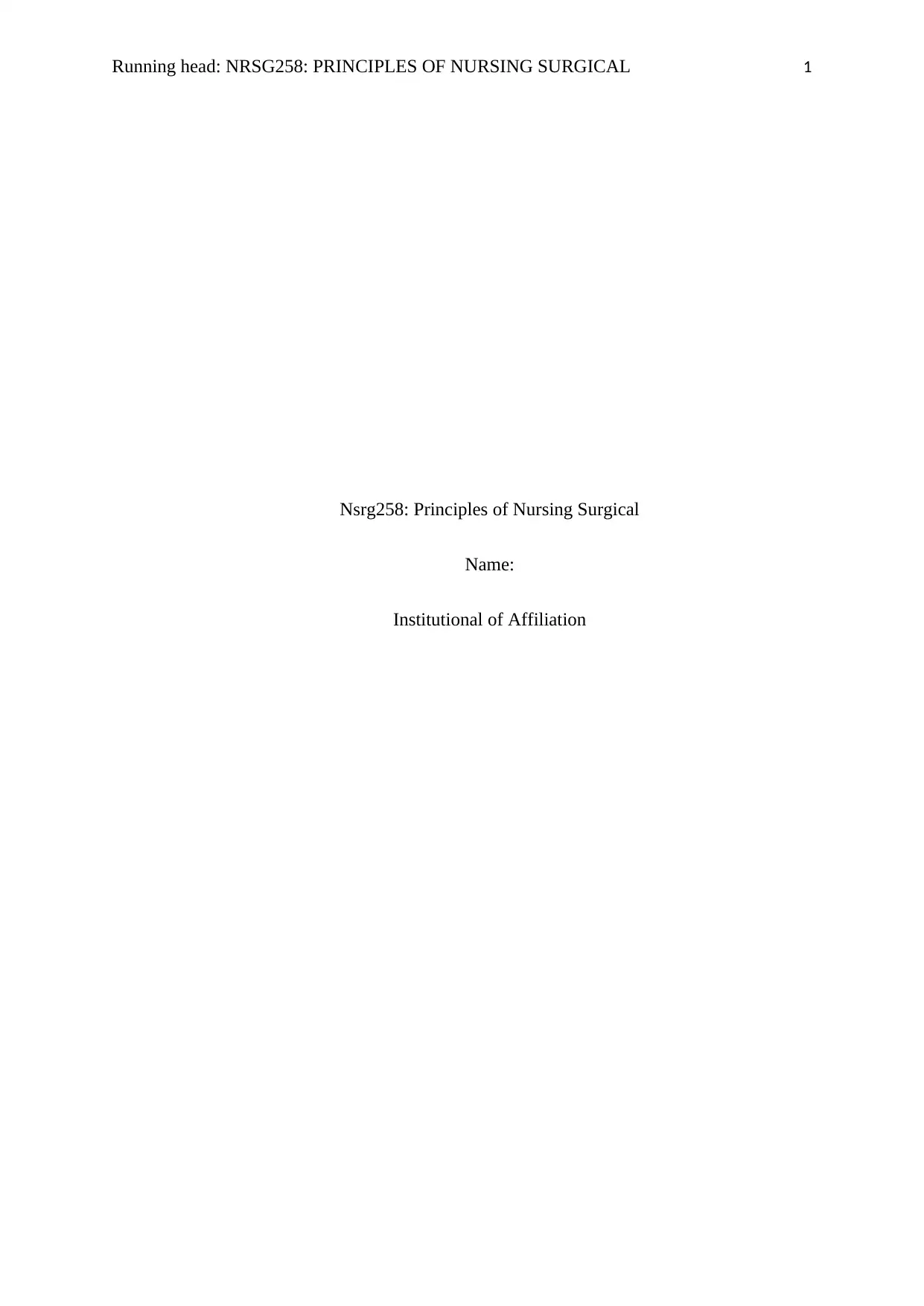
Running head: NRSG258: PRINCIPLES OF NURSING SURGICAL 1
Nsrg258: Principles of Nursing Surgical
Name:
Institutional of Affiliation
Nsrg258: Principles of Nursing Surgical
Name:
Institutional of Affiliation
Paraphrase This Document
Need a fresh take? Get an instant paraphrase of this document with our AI Paraphraser
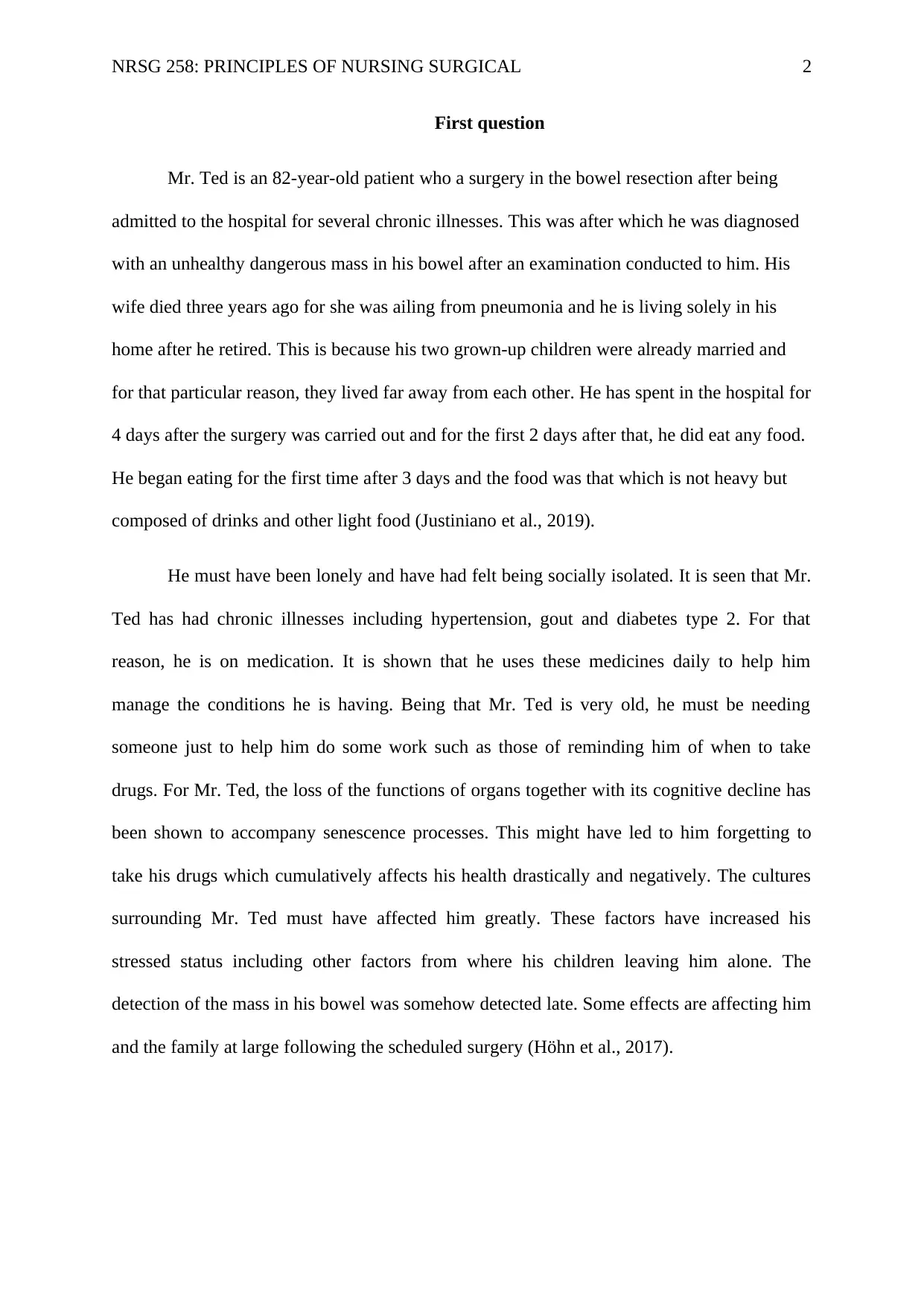
NRSG 258: PRINCIPLES OF NURSING SURGICAL 2
First question
Mr. Ted is an 82-year-old patient who a surgery in the bowel resection after being
admitted to the hospital for several chronic illnesses. This was after which he was diagnosed
with an unhealthy dangerous mass in his bowel after an examination conducted to him. His
wife died three years ago for she was ailing from pneumonia and he is living solely in his
home after he retired. This is because his two grown-up children were already married and
for that particular reason, they lived far away from each other. He has spent in the hospital for
4 days after the surgery was carried out and for the first 2 days after that, he did eat any food.
He began eating for the first time after 3 days and the food was that which is not heavy but
composed of drinks and other light food (Justiniano et al., 2019).
He must have been lonely and have had felt being socially isolated. It is seen that Mr.
Ted has had chronic illnesses including hypertension, gout and diabetes type 2. For that
reason, he is on medication. It is shown that he uses these medicines daily to help him
manage the conditions he is having. Being that Mr. Ted is very old, he must be needing
someone just to help him do some work such as those of reminding him of when to take
drugs. For Mr. Ted, the loss of the functions of organs together with its cognitive decline has
been shown to accompany senescence processes. This might have led to him forgetting to
take his drugs which cumulatively affects his health drastically and negatively. The cultures
surrounding Mr. Ted must have affected him greatly. These factors have increased his
stressed status including other factors from where his children leaving him alone. The
detection of the mass in his bowel was somehow detected late. Some effects are affecting him
and the family at large following the scheduled surgery (Höhn et al., 2017).
First question
Mr. Ted is an 82-year-old patient who a surgery in the bowel resection after being
admitted to the hospital for several chronic illnesses. This was after which he was diagnosed
with an unhealthy dangerous mass in his bowel after an examination conducted to him. His
wife died three years ago for she was ailing from pneumonia and he is living solely in his
home after he retired. This is because his two grown-up children were already married and
for that particular reason, they lived far away from each other. He has spent in the hospital for
4 days after the surgery was carried out and for the first 2 days after that, he did eat any food.
He began eating for the first time after 3 days and the food was that which is not heavy but
composed of drinks and other light food (Justiniano et al., 2019).
He must have been lonely and have had felt being socially isolated. It is seen that Mr.
Ted has had chronic illnesses including hypertension, gout and diabetes type 2. For that
reason, he is on medication. It is shown that he uses these medicines daily to help him
manage the conditions he is having. Being that Mr. Ted is very old, he must be needing
someone just to help him do some work such as those of reminding him of when to take
drugs. For Mr. Ted, the loss of the functions of organs together with its cognitive decline has
been shown to accompany senescence processes. This might have led to him forgetting to
take his drugs which cumulatively affects his health drastically and negatively. The cultures
surrounding Mr. Ted must have affected him greatly. These factors have increased his
stressed status including other factors from where his children leaving him alone. The
detection of the mass in his bowel was somehow detected late. Some effects are affecting him
and the family at large following the scheduled surgery (Höhn et al., 2017).
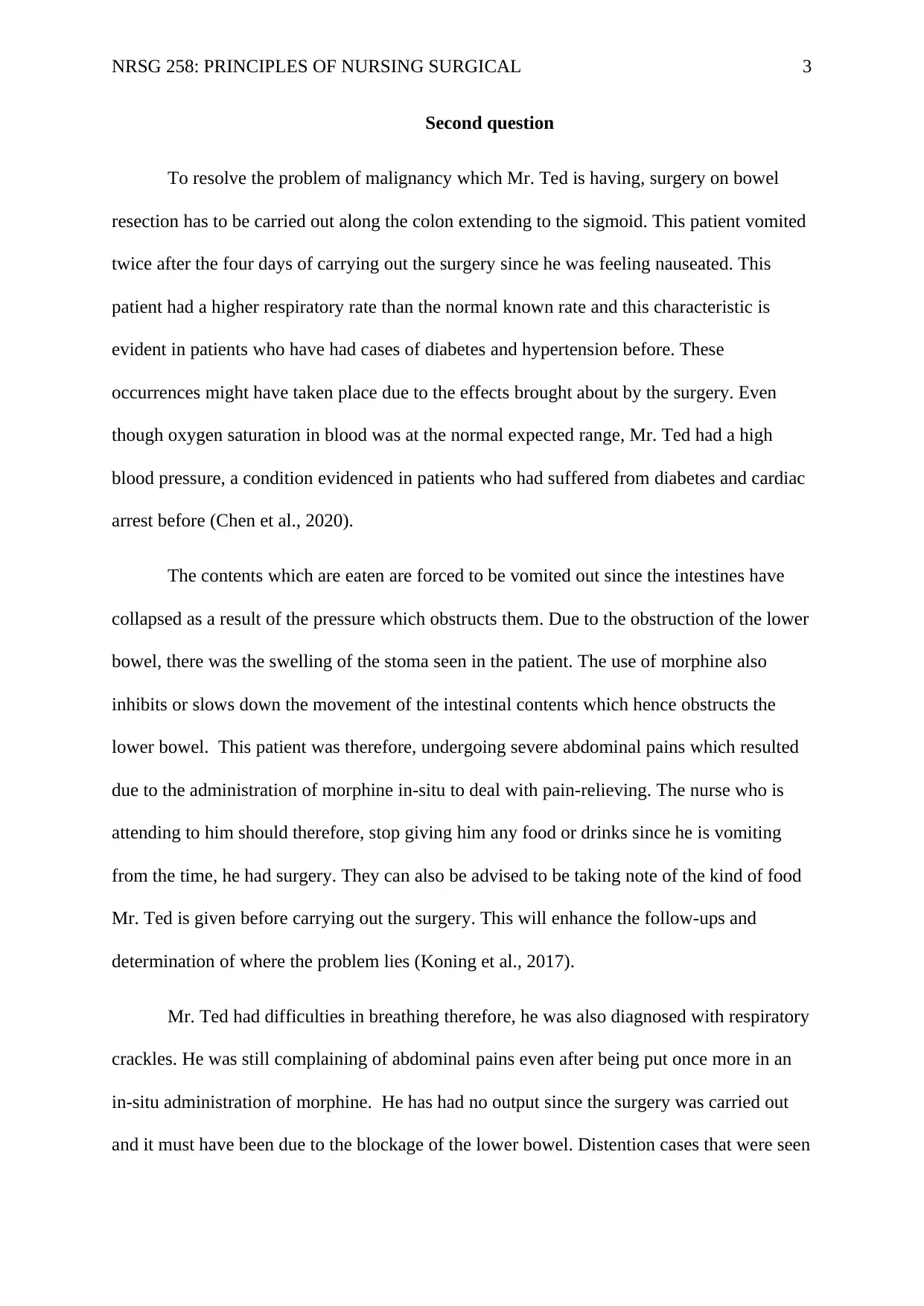
NRSG 258: PRINCIPLES OF NURSING SURGICAL 3
Second question
To resolve the problem of malignancy which Mr. Ted is having, surgery on bowel
resection has to be carried out along the colon extending to the sigmoid. This patient vomited
twice after the four days of carrying out the surgery since he was feeling nauseated. This
patient had a higher respiratory rate than the normal known rate and this characteristic is
evident in patients who have had cases of diabetes and hypertension before. These
occurrences might have taken place due to the effects brought about by the surgery. Even
though oxygen saturation in blood was at the normal expected range, Mr. Ted had a high
blood pressure, a condition evidenced in patients who had suffered from diabetes and cardiac
arrest before (Chen et al., 2020).
The contents which are eaten are forced to be vomited out since the intestines have
collapsed as a result of the pressure which obstructs them. Due to the obstruction of the lower
bowel, there was the swelling of the stoma seen in the patient. The use of morphine also
inhibits or slows down the movement of the intestinal contents which hence obstructs the
lower bowel. This patient was therefore, undergoing severe abdominal pains which resulted
due to the administration of morphine in-situ to deal with pain-relieving. The nurse who is
attending to him should therefore, stop giving him any food or drinks since he is vomiting
from the time, he had surgery. They can also be advised to be taking note of the kind of food
Mr. Ted is given before carrying out the surgery. This will enhance the follow-ups and
determination of where the problem lies (Koning et al., 2017).
Mr. Ted had difficulties in breathing therefore, he was also diagnosed with respiratory
crackles. He was still complaining of abdominal pains even after being put once more in an
in-situ administration of morphine. He has had no output since the surgery was carried out
and it must have been due to the blockage of the lower bowel. Distention cases that were seen
Second question
To resolve the problem of malignancy which Mr. Ted is having, surgery on bowel
resection has to be carried out along the colon extending to the sigmoid. This patient vomited
twice after the four days of carrying out the surgery since he was feeling nauseated. This
patient had a higher respiratory rate than the normal known rate and this characteristic is
evident in patients who have had cases of diabetes and hypertension before. These
occurrences might have taken place due to the effects brought about by the surgery. Even
though oxygen saturation in blood was at the normal expected range, Mr. Ted had a high
blood pressure, a condition evidenced in patients who had suffered from diabetes and cardiac
arrest before (Chen et al., 2020).
The contents which are eaten are forced to be vomited out since the intestines have
collapsed as a result of the pressure which obstructs them. Due to the obstruction of the lower
bowel, there was the swelling of the stoma seen in the patient. The use of morphine also
inhibits or slows down the movement of the intestinal contents which hence obstructs the
lower bowel. This patient was therefore, undergoing severe abdominal pains which resulted
due to the administration of morphine in-situ to deal with pain-relieving. The nurse who is
attending to him should therefore, stop giving him any food or drinks since he is vomiting
from the time, he had surgery. They can also be advised to be taking note of the kind of food
Mr. Ted is given before carrying out the surgery. This will enhance the follow-ups and
determination of where the problem lies (Koning et al., 2017).
Mr. Ted had difficulties in breathing therefore, he was also diagnosed with respiratory
crackles. He was still complaining of abdominal pains even after being put once more in an
in-situ administration of morphine. He has had no output since the surgery was carried out
and it must have been due to the blockage of the lower bowel. Distention cases that were seen
⊘ This is a preview!⊘
Do you want full access?
Subscribe today to unlock all pages.

Trusted by 1+ million students worldwide
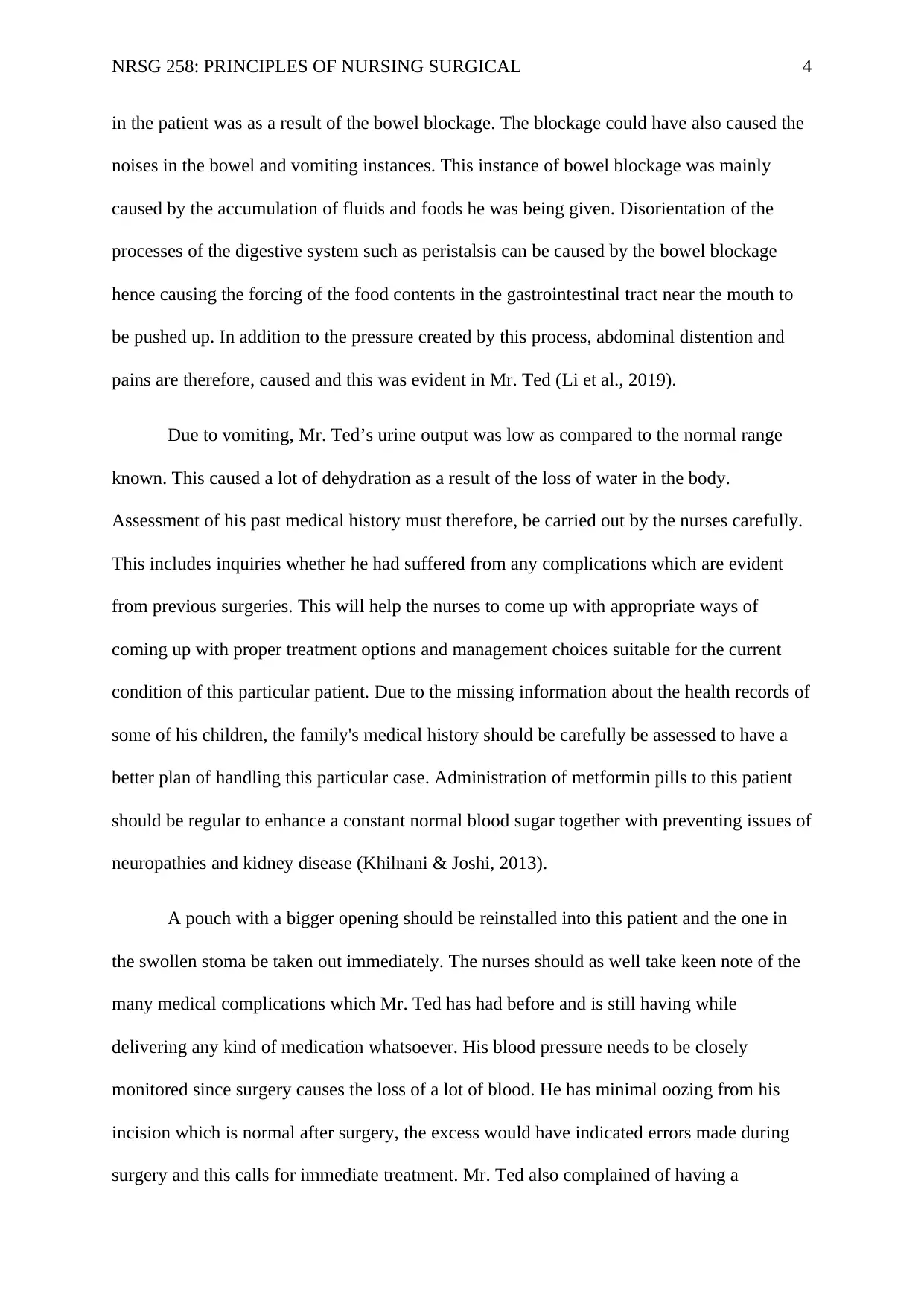
NRSG 258: PRINCIPLES OF NURSING SURGICAL 4
in the patient was as a result of the bowel blockage. The blockage could have also caused the
noises in the bowel and vomiting instances. This instance of bowel blockage was mainly
caused by the accumulation of fluids and foods he was being given. Disorientation of the
processes of the digestive system such as peristalsis can be caused by the bowel blockage
hence causing the forcing of the food contents in the gastrointestinal tract near the mouth to
be pushed up. In addition to the pressure created by this process, abdominal distention and
pains are therefore, caused and this was evident in Mr. Ted (Li et al., 2019).
Due to vomiting, Mr. Ted’s urine output was low as compared to the normal range
known. This caused a lot of dehydration as a result of the loss of water in the body.
Assessment of his past medical history must therefore, be carried out by the nurses carefully.
This includes inquiries whether he had suffered from any complications which are evident
from previous surgeries. This will help the nurses to come up with appropriate ways of
coming up with proper treatment options and management choices suitable for the current
condition of this particular patient. Due to the missing information about the health records of
some of his children, the family's medical history should be carefully be assessed to have a
better plan of handling this particular case. Administration of metformin pills to this patient
should be regular to enhance a constant normal blood sugar together with preventing issues of
neuropathies and kidney disease (Khilnani & Joshi, 2013).
A pouch with a bigger opening should be reinstalled into this patient and the one in
the swollen stoma be taken out immediately. The nurses should as well take keen note of the
many medical complications which Mr. Ted has had before and is still having while
delivering any kind of medication whatsoever. His blood pressure needs to be closely
monitored since surgery causes the loss of a lot of blood. He has minimal oozing from his
incision which is normal after surgery, the excess would have indicated errors made during
surgery and this calls for immediate treatment. Mr. Ted also complained of having a
in the patient was as a result of the bowel blockage. The blockage could have also caused the
noises in the bowel and vomiting instances. This instance of bowel blockage was mainly
caused by the accumulation of fluids and foods he was being given. Disorientation of the
processes of the digestive system such as peristalsis can be caused by the bowel blockage
hence causing the forcing of the food contents in the gastrointestinal tract near the mouth to
be pushed up. In addition to the pressure created by this process, abdominal distention and
pains are therefore, caused and this was evident in Mr. Ted (Li et al., 2019).
Due to vomiting, Mr. Ted’s urine output was low as compared to the normal range
known. This caused a lot of dehydration as a result of the loss of water in the body.
Assessment of his past medical history must therefore, be carried out by the nurses carefully.
This includes inquiries whether he had suffered from any complications which are evident
from previous surgeries. This will help the nurses to come up with appropriate ways of
coming up with proper treatment options and management choices suitable for the current
condition of this particular patient. Due to the missing information about the health records of
some of his children, the family's medical history should be carefully be assessed to have a
better plan of handling this particular case. Administration of metformin pills to this patient
should be regular to enhance a constant normal blood sugar together with preventing issues of
neuropathies and kidney disease (Khilnani & Joshi, 2013).
A pouch with a bigger opening should be reinstalled into this patient and the one in
the swollen stoma be taken out immediately. The nurses should as well take keen note of the
many medical complications which Mr. Ted has had before and is still having while
delivering any kind of medication whatsoever. His blood pressure needs to be closely
monitored since surgery causes the loss of a lot of blood. He has minimal oozing from his
incision which is normal after surgery, the excess would have indicated errors made during
surgery and this calls for immediate treatment. Mr. Ted also complained of having a
Paraphrase This Document
Need a fresh take? Get an instant paraphrase of this document with our AI Paraphraser
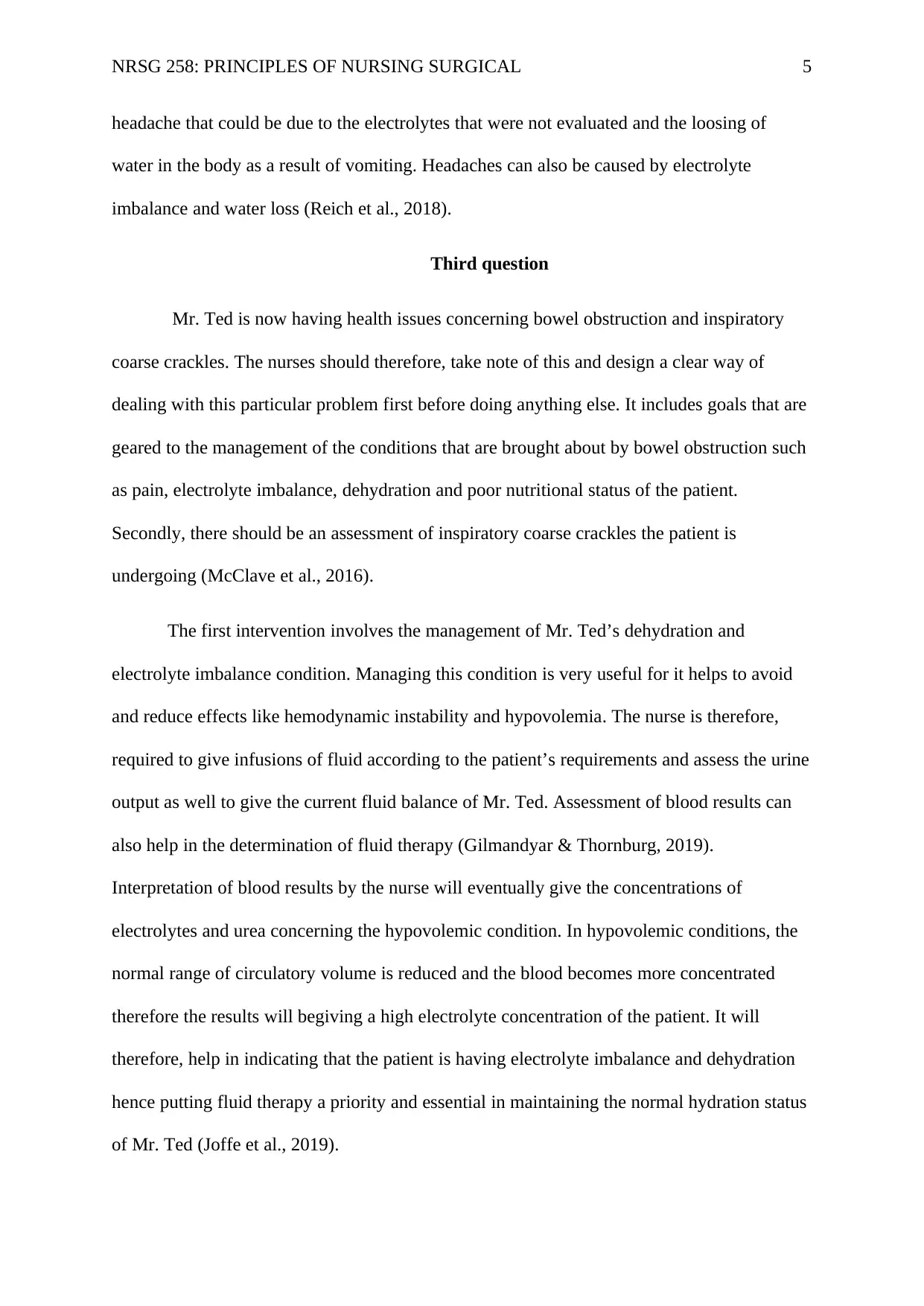
NRSG 258: PRINCIPLES OF NURSING SURGICAL 5
headache that could be due to the electrolytes that were not evaluated and the loosing of
water in the body as a result of vomiting. Headaches can also be caused by electrolyte
imbalance and water loss (Reich et al., 2018).
Third question
Mr. Ted is now having health issues concerning bowel obstruction and inspiratory
coarse crackles. The nurses should therefore, take note of this and design a clear way of
dealing with this particular problem first before doing anything else. It includes goals that are
geared to the management of the conditions that are brought about by bowel obstruction such
as pain, electrolyte imbalance, dehydration and poor nutritional status of the patient.
Secondly, there should be an assessment of inspiratory coarse crackles the patient is
undergoing (McClave et al., 2016).
The first intervention involves the management of Mr. Ted’s dehydration and
electrolyte imbalance condition. Managing this condition is very useful for it helps to avoid
and reduce effects like hemodynamic instability and hypovolemia. The nurse is therefore,
required to give infusions of fluid according to the patient’s requirements and assess the urine
output as well to give the current fluid balance of Mr. Ted. Assessment of blood results can
also help in the determination of fluid therapy (Gilmandyar & Thornburg, 2019).
Interpretation of blood results by the nurse will eventually give the concentrations of
electrolytes and urea concerning the hypovolemic condition. In hypovolemic conditions, the
normal range of circulatory volume is reduced and the blood becomes more concentrated
therefore the results will begiving a high electrolyte concentration of the patient. It will
therefore, help in indicating that the patient is having electrolyte imbalance and dehydration
hence putting fluid therapy a priority and essential in maintaining the normal hydration status
of Mr. Ted (Joffe et al., 2019).
headache that could be due to the electrolytes that were not evaluated and the loosing of
water in the body as a result of vomiting. Headaches can also be caused by electrolyte
imbalance and water loss (Reich et al., 2018).
Third question
Mr. Ted is now having health issues concerning bowel obstruction and inspiratory
coarse crackles. The nurses should therefore, take note of this and design a clear way of
dealing with this particular problem first before doing anything else. It includes goals that are
geared to the management of the conditions that are brought about by bowel obstruction such
as pain, electrolyte imbalance, dehydration and poor nutritional status of the patient.
Secondly, there should be an assessment of inspiratory coarse crackles the patient is
undergoing (McClave et al., 2016).
The first intervention involves the management of Mr. Ted’s dehydration and
electrolyte imbalance condition. Managing this condition is very useful for it helps to avoid
and reduce effects like hemodynamic instability and hypovolemia. The nurse is therefore,
required to give infusions of fluid according to the patient’s requirements and assess the urine
output as well to give the current fluid balance of Mr. Ted. Assessment of blood results can
also help in the determination of fluid therapy (Gilmandyar & Thornburg, 2019).
Interpretation of blood results by the nurse will eventually give the concentrations of
electrolytes and urea concerning the hypovolemic condition. In hypovolemic conditions, the
normal range of circulatory volume is reduced and the blood becomes more concentrated
therefore the results will begiving a high electrolyte concentration of the patient. It will
therefore, help in indicating that the patient is having electrolyte imbalance and dehydration
hence putting fluid therapy a priority and essential in maintaining the normal hydration status
of Mr. Ted (Joffe et al., 2019).
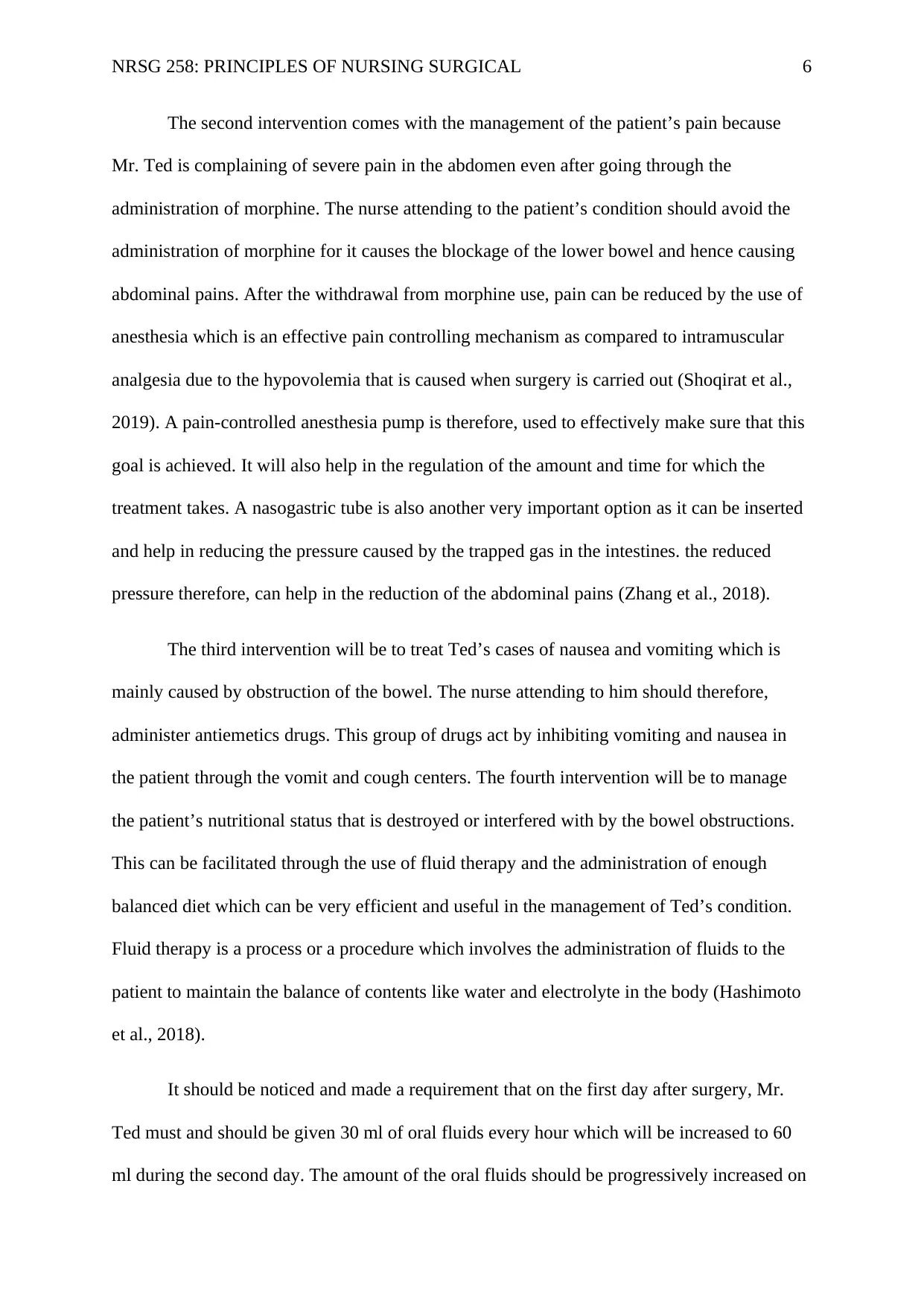
NRSG 258: PRINCIPLES OF NURSING SURGICAL 6
The second intervention comes with the management of the patient’s pain because
Mr. Ted is complaining of severe pain in the abdomen even after going through the
administration of morphine. The nurse attending to the patient’s condition should avoid the
administration of morphine for it causes the blockage of the lower bowel and hence causing
abdominal pains. After the withdrawal from morphine use, pain can be reduced by the use of
anesthesia which is an effective pain controlling mechanism as compared to intramuscular
analgesia due to the hypovolemia that is caused when surgery is carried out (Shoqirat et al.,
2019). A pain-controlled anesthesia pump is therefore, used to effectively make sure that this
goal is achieved. It will also help in the regulation of the amount and time for which the
treatment takes. A nasogastric tube is also another very important option as it can be inserted
and help in reducing the pressure caused by the trapped gas in the intestines. the reduced
pressure therefore, can help in the reduction of the abdominal pains (Zhang et al., 2018).
The third intervention will be to treat Ted’s cases of nausea and vomiting which is
mainly caused by obstruction of the bowel. The nurse attending to him should therefore,
administer antiemetics drugs. This group of drugs act by inhibiting vomiting and nausea in
the patient through the vomit and cough centers. The fourth intervention will be to manage
the patient’s nutritional status that is destroyed or interfered with by the bowel obstructions.
This can be facilitated through the use of fluid therapy and the administration of enough
balanced diet which can be very efficient and useful in the management of Ted’s condition.
Fluid therapy is a process or a procedure which involves the administration of fluids to the
patient to maintain the balance of contents like water and electrolyte in the body (Hashimoto
et al., 2018).
It should be noticed and made a requirement that on the first day after surgery, Mr.
Ted must and should be given 30 ml of oral fluids every hour which will be increased to 60
ml during the second day. The amount of the oral fluids should be progressively increased on
The second intervention comes with the management of the patient’s pain because
Mr. Ted is complaining of severe pain in the abdomen even after going through the
administration of morphine. The nurse attending to the patient’s condition should avoid the
administration of morphine for it causes the blockage of the lower bowel and hence causing
abdominal pains. After the withdrawal from morphine use, pain can be reduced by the use of
anesthesia which is an effective pain controlling mechanism as compared to intramuscular
analgesia due to the hypovolemia that is caused when surgery is carried out (Shoqirat et al.,
2019). A pain-controlled anesthesia pump is therefore, used to effectively make sure that this
goal is achieved. It will also help in the regulation of the amount and time for which the
treatment takes. A nasogastric tube is also another very important option as it can be inserted
and help in reducing the pressure caused by the trapped gas in the intestines. the reduced
pressure therefore, can help in the reduction of the abdominal pains (Zhang et al., 2018).
The third intervention will be to treat Ted’s cases of nausea and vomiting which is
mainly caused by obstruction of the bowel. The nurse attending to him should therefore,
administer antiemetics drugs. This group of drugs act by inhibiting vomiting and nausea in
the patient through the vomit and cough centers. The fourth intervention will be to manage
the patient’s nutritional status that is destroyed or interfered with by the bowel obstructions.
This can be facilitated through the use of fluid therapy and the administration of enough
balanced diet which can be very efficient and useful in the management of Ted’s condition.
Fluid therapy is a process or a procedure which involves the administration of fluids to the
patient to maintain the balance of contents like water and electrolyte in the body (Hashimoto
et al., 2018).
It should be noticed and made a requirement that on the first day after surgery, Mr.
Ted must and should be given 30 ml of oral fluids every hour which will be increased to 60
ml during the second day. The amount of the oral fluids should be progressively increased on
⊘ This is a preview!⊘
Do you want full access?
Subscribe today to unlock all pages.

Trusted by 1+ million students worldwide
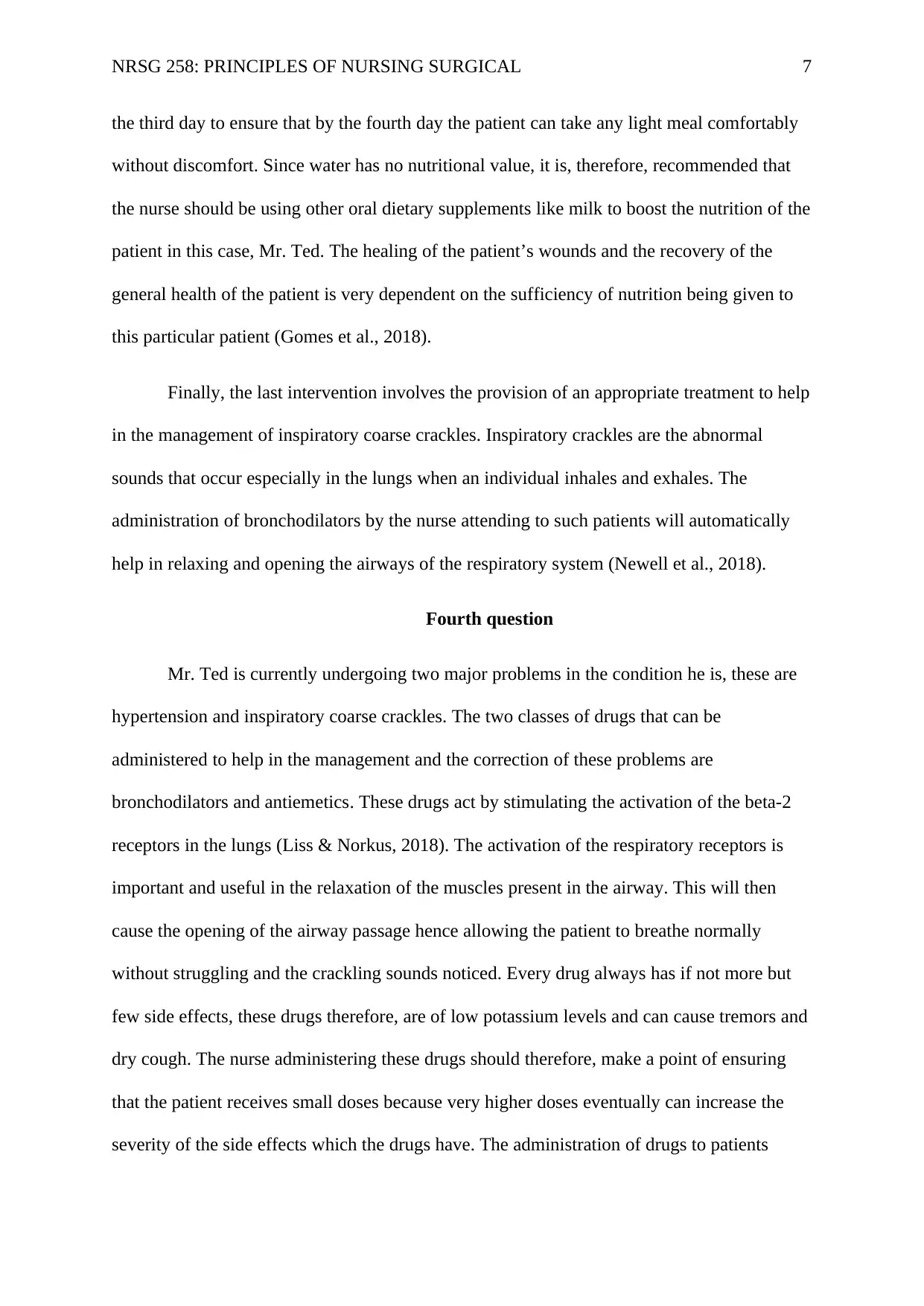
NRSG 258: PRINCIPLES OF NURSING SURGICAL 7
the third day to ensure that by the fourth day the patient can take any light meal comfortably
without discomfort. Since water has no nutritional value, it is, therefore, recommended that
the nurse should be using other oral dietary supplements like milk to boost the nutrition of the
patient in this case, Mr. Ted. The healing of the patient’s wounds and the recovery of the
general health of the patient is very dependent on the sufficiency of nutrition being given to
this particular patient (Gomes et al., 2018).
Finally, the last intervention involves the provision of an appropriate treatment to help
in the management of inspiratory coarse crackles. Inspiratory crackles are the abnormal
sounds that occur especially in the lungs when an individual inhales and exhales. The
administration of bronchodilators by the nurse attending to such patients will automatically
help in relaxing and opening the airways of the respiratory system (Newell et al., 2018).
Fourth question
Mr. Ted is currently undergoing two major problems in the condition he is, these are
hypertension and inspiratory coarse crackles. The two classes of drugs that can be
administered to help in the management and the correction of these problems are
bronchodilators and antiemetics. These drugs act by stimulating the activation of the beta-2
receptors in the lungs (Liss & Norkus, 2018). The activation of the respiratory receptors is
important and useful in the relaxation of the muscles present in the airway. This will then
cause the opening of the airway passage hence allowing the patient to breathe normally
without struggling and the crackling sounds noticed. Every drug always has if not more but
few side effects, these drugs therefore, are of low potassium levels and can cause tremors and
dry cough. The nurse administering these drugs should therefore, make a point of ensuring
that the patient receives small doses because very higher doses eventually can increase the
severity of the side effects which the drugs have. The administration of drugs to patients
the third day to ensure that by the fourth day the patient can take any light meal comfortably
without discomfort. Since water has no nutritional value, it is, therefore, recommended that
the nurse should be using other oral dietary supplements like milk to boost the nutrition of the
patient in this case, Mr. Ted. The healing of the patient’s wounds and the recovery of the
general health of the patient is very dependent on the sufficiency of nutrition being given to
this particular patient (Gomes et al., 2018).
Finally, the last intervention involves the provision of an appropriate treatment to help
in the management of inspiratory coarse crackles. Inspiratory crackles are the abnormal
sounds that occur especially in the lungs when an individual inhales and exhales. The
administration of bronchodilators by the nurse attending to such patients will automatically
help in relaxing and opening the airways of the respiratory system (Newell et al., 2018).
Fourth question
Mr. Ted is currently undergoing two major problems in the condition he is, these are
hypertension and inspiratory coarse crackles. The two classes of drugs that can be
administered to help in the management and the correction of these problems are
bronchodilators and antiemetics. These drugs act by stimulating the activation of the beta-2
receptors in the lungs (Liss & Norkus, 2018). The activation of the respiratory receptors is
important and useful in the relaxation of the muscles present in the airway. This will then
cause the opening of the airway passage hence allowing the patient to breathe normally
without struggling and the crackling sounds noticed. Every drug always has if not more but
few side effects, these drugs therefore, are of low potassium levels and can cause tremors and
dry cough. The nurse administering these drugs should therefore, make a point of ensuring
that the patient receives small doses because very higher doses eventually can increase the
severity of the side effects which the drugs have. The administration of drugs to patients
Paraphrase This Document
Need a fresh take? Get an instant paraphrase of this document with our AI Paraphraser
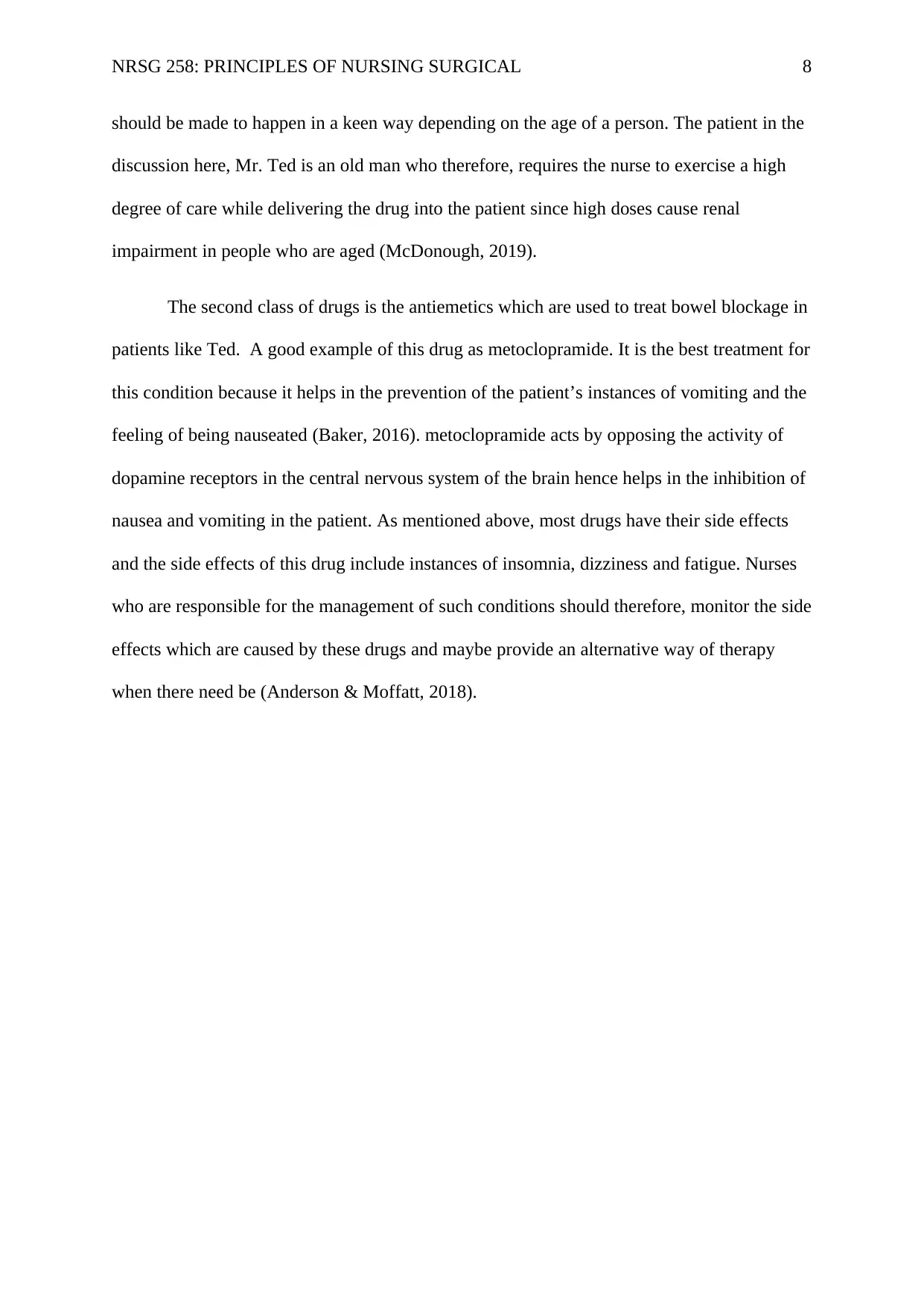
NRSG 258: PRINCIPLES OF NURSING SURGICAL 8
should be made to happen in a keen way depending on the age of a person. The patient in the
discussion here, Mr. Ted is an old man who therefore, requires the nurse to exercise a high
degree of care while delivering the drug into the patient since high doses cause renal
impairment in people who are aged (McDonough, 2019).
The second class of drugs is the antiemetics which are used to treat bowel blockage in
patients like Ted. A good example of this drug as metoclopramide. It is the best treatment for
this condition because it helps in the prevention of the patient’s instances of vomiting and the
feeling of being nauseated (Baker, 2016). metoclopramide acts by opposing the activity of
dopamine receptors in the central nervous system of the brain hence helps in the inhibition of
nausea and vomiting in the patient. As mentioned above, most drugs have their side effects
and the side effects of this drug include instances of insomnia, dizziness and fatigue. Nurses
who are responsible for the management of such conditions should therefore, monitor the side
effects which are caused by these drugs and maybe provide an alternative way of therapy
when there need be (Anderson & Moffatt, 2018).
should be made to happen in a keen way depending on the age of a person. The patient in the
discussion here, Mr. Ted is an old man who therefore, requires the nurse to exercise a high
degree of care while delivering the drug into the patient since high doses cause renal
impairment in people who are aged (McDonough, 2019).
The second class of drugs is the antiemetics which are used to treat bowel blockage in
patients like Ted. A good example of this drug as metoclopramide. It is the best treatment for
this condition because it helps in the prevention of the patient’s instances of vomiting and the
feeling of being nauseated (Baker, 2016). metoclopramide acts by opposing the activity of
dopamine receptors in the central nervous system of the brain hence helps in the inhibition of
nausea and vomiting in the patient. As mentioned above, most drugs have their side effects
and the side effects of this drug include instances of insomnia, dizziness and fatigue. Nurses
who are responsible for the management of such conditions should therefore, monitor the side
effects which are caused by these drugs and maybe provide an alternative way of therapy
when there need be (Anderson & Moffatt, 2018).
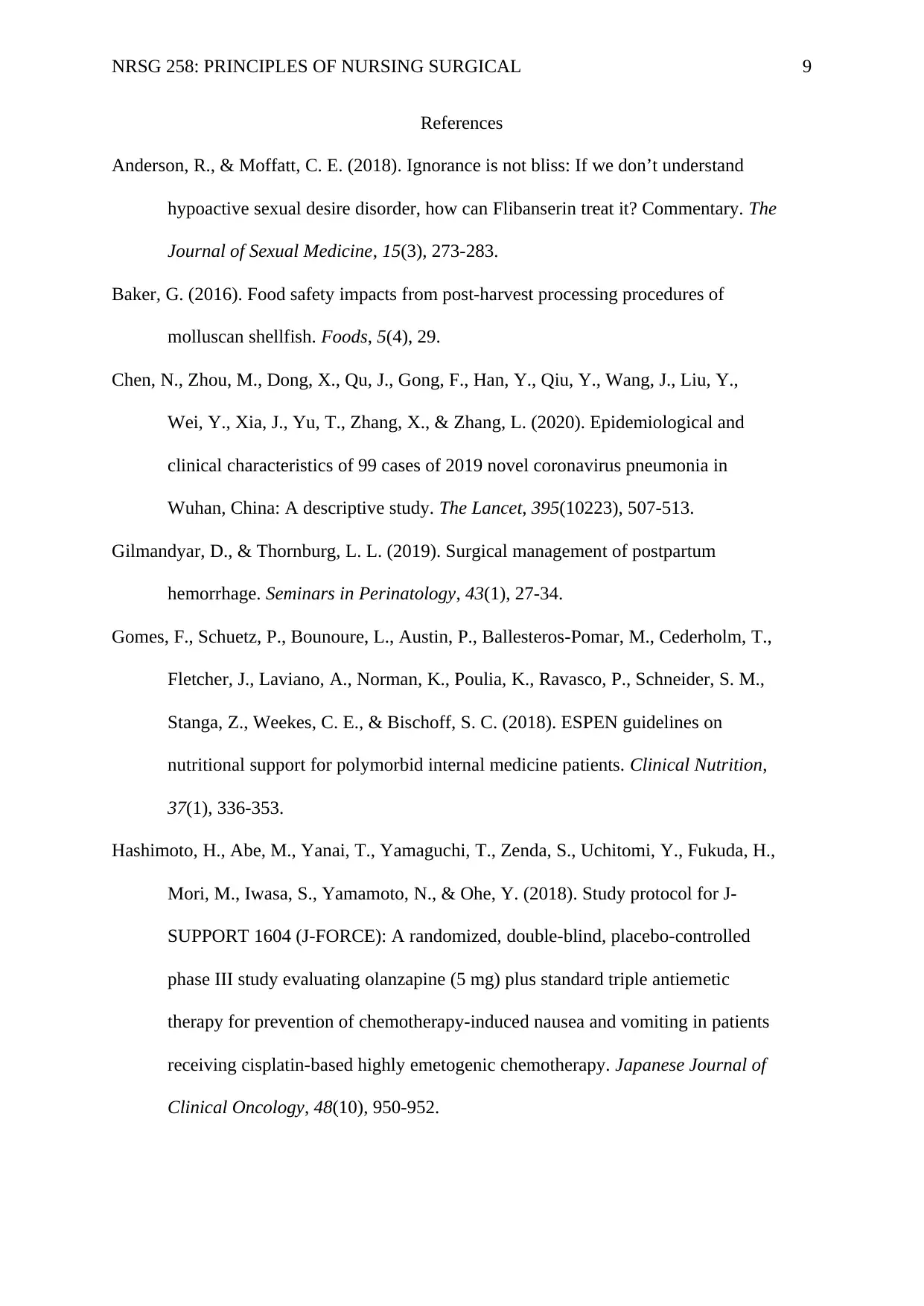
NRSG 258: PRINCIPLES OF NURSING SURGICAL 9
References
Anderson, R., & Moffatt, C. E. (2018). Ignorance is not bliss: If we don’t understand
hypoactive sexual desire disorder, how can Flibanserin treat it? Commentary. The
Journal of Sexual Medicine, 15(3), 273-283.
Baker, G. (2016). Food safety impacts from post-harvest processing procedures of
molluscan shellfish. Foods, 5(4), 29.
Chen, N., Zhou, M., Dong, X., Qu, J., Gong, F., Han, Y., Qiu, Y., Wang, J., Liu, Y.,
Wei, Y., Xia, J., Yu, T., Zhang, X., & Zhang, L. (2020). Epidemiological and
clinical characteristics of 99 cases of 2019 novel coronavirus pneumonia in
Wuhan, China: A descriptive study. The Lancet, 395(10223), 507-513.
Gilmandyar, D., & Thornburg, L. L. (2019). Surgical management of postpartum
hemorrhage. Seminars in Perinatology, 43(1), 27-34.
Gomes, F., Schuetz, P., Bounoure, L., Austin, P., Ballesteros-Pomar, M., Cederholm, T.,
Fletcher, J., Laviano, A., Norman, K., Poulia, K., Ravasco, P., Schneider, S. M.,
Stanga, Z., Weekes, C. E., & Bischoff, S. C. (2018). ESPEN guidelines on
nutritional support for polymorbid internal medicine patients. Clinical Nutrition,
37(1), 336-353.
Hashimoto, H., Abe, M., Yanai, T., Yamaguchi, T., Zenda, S., Uchitomi, Y., Fukuda, H.,
Mori, M., Iwasa, S., Yamamoto, N., & Ohe, Y. (2018). Study protocol for J-
SUPPORT 1604 (J-FORCE): A randomized, double-blind, placebo-controlled
phase III study evaluating olanzapine (5 mg) plus standard triple antiemetic
therapy for prevention of chemotherapy-induced nausea and vomiting in patients
receiving cisplatin-based highly emetogenic chemotherapy. Japanese Journal of
Clinical Oncology, 48(10), 950-952.
References
Anderson, R., & Moffatt, C. E. (2018). Ignorance is not bliss: If we don’t understand
hypoactive sexual desire disorder, how can Flibanserin treat it? Commentary. The
Journal of Sexual Medicine, 15(3), 273-283.
Baker, G. (2016). Food safety impacts from post-harvest processing procedures of
molluscan shellfish. Foods, 5(4), 29.
Chen, N., Zhou, M., Dong, X., Qu, J., Gong, F., Han, Y., Qiu, Y., Wang, J., Liu, Y.,
Wei, Y., Xia, J., Yu, T., Zhang, X., & Zhang, L. (2020). Epidemiological and
clinical characteristics of 99 cases of 2019 novel coronavirus pneumonia in
Wuhan, China: A descriptive study. The Lancet, 395(10223), 507-513.
Gilmandyar, D., & Thornburg, L. L. (2019). Surgical management of postpartum
hemorrhage. Seminars in Perinatology, 43(1), 27-34.
Gomes, F., Schuetz, P., Bounoure, L., Austin, P., Ballesteros-Pomar, M., Cederholm, T.,
Fletcher, J., Laviano, A., Norman, K., Poulia, K., Ravasco, P., Schneider, S. M.,
Stanga, Z., Weekes, C. E., & Bischoff, S. C. (2018). ESPEN guidelines on
nutritional support for polymorbid internal medicine patients. Clinical Nutrition,
37(1), 336-353.
Hashimoto, H., Abe, M., Yanai, T., Yamaguchi, T., Zenda, S., Uchitomi, Y., Fukuda, H.,
Mori, M., Iwasa, S., Yamamoto, N., & Ohe, Y. (2018). Study protocol for J-
SUPPORT 1604 (J-FORCE): A randomized, double-blind, placebo-controlled
phase III study evaluating olanzapine (5 mg) plus standard triple antiemetic
therapy for prevention of chemotherapy-induced nausea and vomiting in patients
receiving cisplatin-based highly emetogenic chemotherapy. Japanese Journal of
Clinical Oncology, 48(10), 950-952.
⊘ This is a preview!⊘
Do you want full access?
Subscribe today to unlock all pages.

Trusted by 1+ million students worldwide
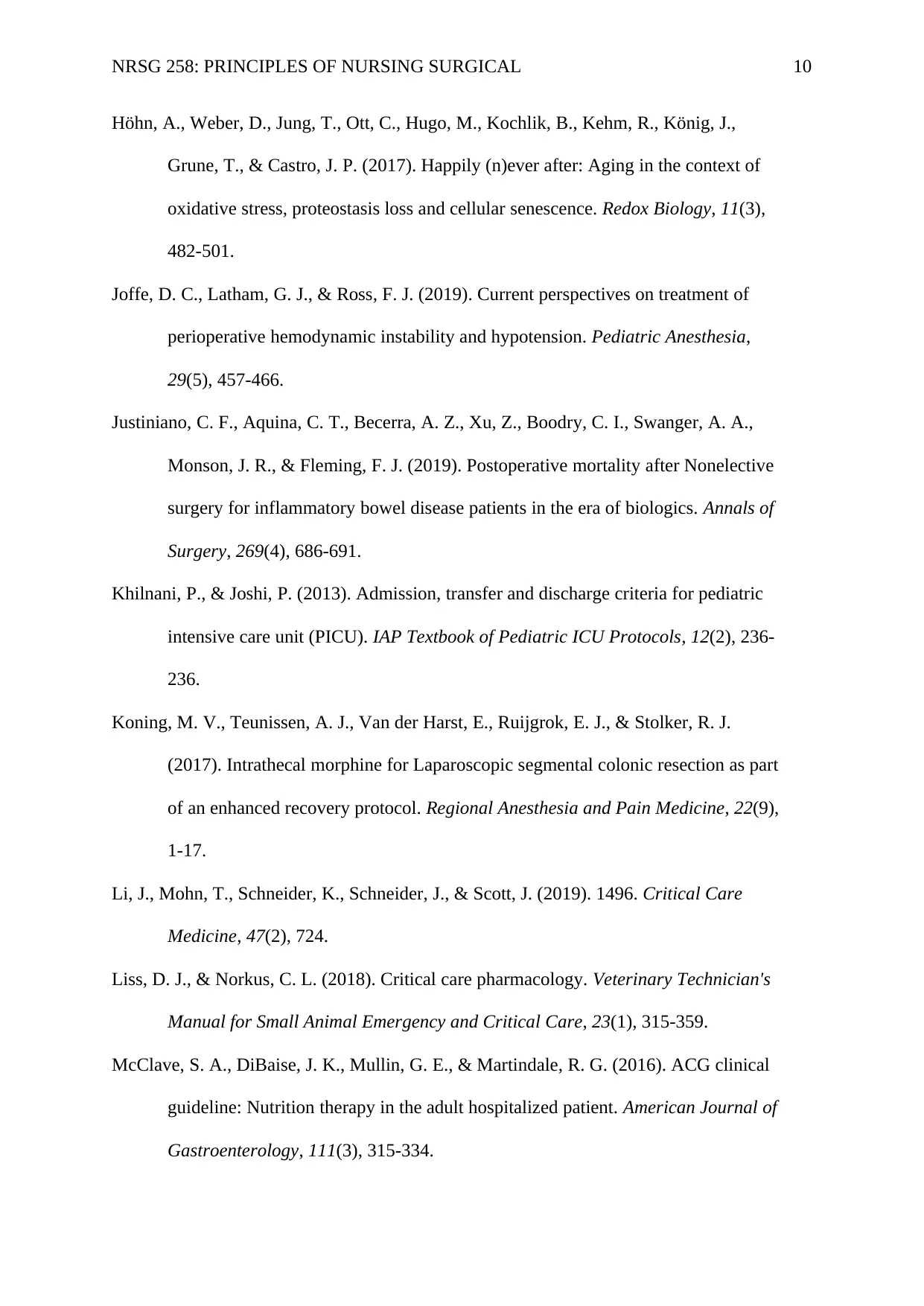
NRSG 258: PRINCIPLES OF NURSING SURGICAL 10
Höhn, A., Weber, D., Jung, T., Ott, C., Hugo, M., Kochlik, B., Kehm, R., König, J.,
Grune, T., & Castro, J. P. (2017). Happily (n)ever after: Aging in the context of
oxidative stress, proteostasis loss and cellular senescence. Redox Biology, 11(3),
482-501.
Joffe, D. C., Latham, G. J., & Ross, F. J. (2019). Current perspectives on treatment of
perioperative hemodynamic instability and hypotension. Pediatric Anesthesia,
29(5), 457-466.
Justiniano, C. F., Aquina, C. T., Becerra, A. Z., Xu, Z., Boodry, C. I., Swanger, A. A.,
Monson, J. R., & Fleming, F. J. (2019). Postoperative mortality after Nonelective
surgery for inflammatory bowel disease patients in the era of biologics. Annals of
Surgery, 269(4), 686-691.
Khilnani, P., & Joshi, P. (2013). Admission, transfer and discharge criteria for pediatric
intensive care unit (PICU). IAP Textbook of Pediatric ICU Protocols, 12(2), 236-
236.
Koning, M. V., Teunissen, A. J., Van der Harst, E., Ruijgrok, E. J., & Stolker, R. J.
(2017). Intrathecal morphine for Laparoscopic segmental colonic resection as part
of an enhanced recovery protocol. Regional Anesthesia and Pain Medicine, 22(9),
1-17.
Li, J., Mohn, T., Schneider, K., Schneider, J., & Scott, J. (2019). 1496. Critical Care
Medicine, 47(2), 724.
Liss, D. J., & Norkus, C. L. (2018). Critical care pharmacology. Veterinary Technician's
Manual for Small Animal Emergency and Critical Care, 23(1), 315-359.
McClave, S. A., DiBaise, J. K., Mullin, G. E., & Martindale, R. G. (2016). ACG clinical
guideline: Nutrition therapy in the adult hospitalized patient. American Journal of
Gastroenterology, 111(3), 315-334.
Höhn, A., Weber, D., Jung, T., Ott, C., Hugo, M., Kochlik, B., Kehm, R., König, J.,
Grune, T., & Castro, J. P. (2017). Happily (n)ever after: Aging in the context of
oxidative stress, proteostasis loss and cellular senescence. Redox Biology, 11(3),
482-501.
Joffe, D. C., Latham, G. J., & Ross, F. J. (2019). Current perspectives on treatment of
perioperative hemodynamic instability and hypotension. Pediatric Anesthesia,
29(5), 457-466.
Justiniano, C. F., Aquina, C. T., Becerra, A. Z., Xu, Z., Boodry, C. I., Swanger, A. A.,
Monson, J. R., & Fleming, F. J. (2019). Postoperative mortality after Nonelective
surgery for inflammatory bowel disease patients in the era of biologics. Annals of
Surgery, 269(4), 686-691.
Khilnani, P., & Joshi, P. (2013). Admission, transfer and discharge criteria for pediatric
intensive care unit (PICU). IAP Textbook of Pediatric ICU Protocols, 12(2), 236-
236.
Koning, M. V., Teunissen, A. J., Van der Harst, E., Ruijgrok, E. J., & Stolker, R. J.
(2017). Intrathecal morphine for Laparoscopic segmental colonic resection as part
of an enhanced recovery protocol. Regional Anesthesia and Pain Medicine, 22(9),
1-17.
Li, J., Mohn, T., Schneider, K., Schneider, J., & Scott, J. (2019). 1496. Critical Care
Medicine, 47(2), 724.
Liss, D. J., & Norkus, C. L. (2018). Critical care pharmacology. Veterinary Technician's
Manual for Small Animal Emergency and Critical Care, 23(1), 315-359.
McClave, S. A., DiBaise, J. K., Mullin, G. E., & Martindale, R. G. (2016). ACG clinical
guideline: Nutrition therapy in the adult hospitalized patient. American Journal of
Gastroenterology, 111(3), 315-334.
Paraphrase This Document
Need a fresh take? Get an instant paraphrase of this document with our AI Paraphraser
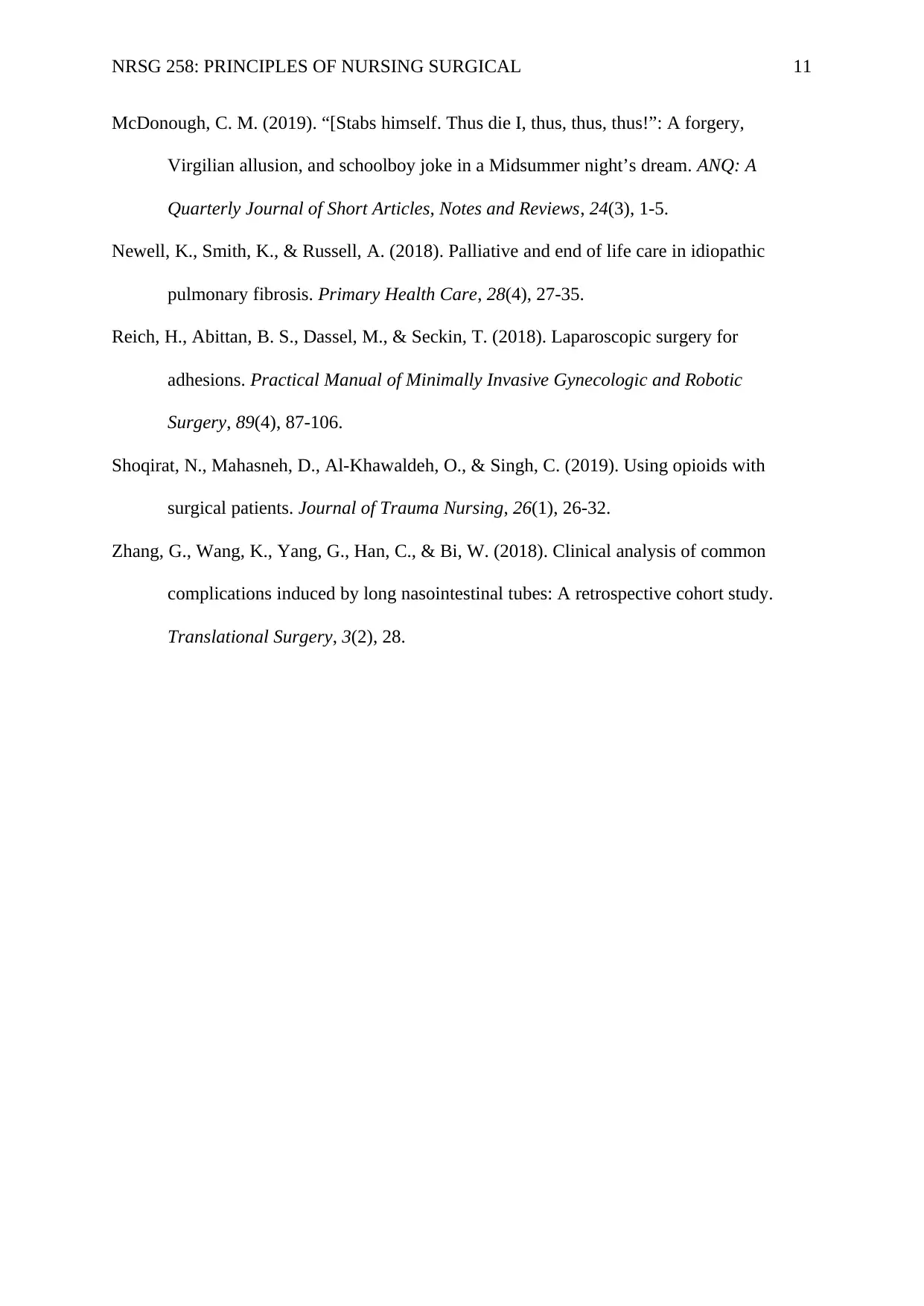
NRSG 258: PRINCIPLES OF NURSING SURGICAL 11
McDonough, C. M. (2019). “[Stabs himself. Thus die I, thus, thus, thus!”: A forgery,
Virgilian allusion, and schoolboy joke in a Midsummer night’s dream. ANQ: A
Quarterly Journal of Short Articles, Notes and Reviews, 24(3), 1-5.
Newell, K., Smith, K., & Russell, A. (2018). Palliative and end of life care in idiopathic
pulmonary fibrosis. Primary Health Care, 28(4), 27-35.
Reich, H., Abittan, B. S., Dassel, M., & Seckin, T. (2018). Laparoscopic surgery for
adhesions. Practical Manual of Minimally Invasive Gynecologic and Robotic
Surgery, 89(4), 87-106.
Shoqirat, N., Mahasneh, D., Al-Khawaldeh, O., & Singh, C. (2019). Using opioids with
surgical patients. Journal of Trauma Nursing, 26(1), 26-32.
Zhang, G., Wang, K., Yang, G., Han, C., & Bi, W. (2018). Clinical analysis of common
complications induced by long nasointestinal tubes: A retrospective cohort study.
Translational Surgery, 3(2), 28.
McDonough, C. M. (2019). “[Stabs himself. Thus die I, thus, thus, thus!”: A forgery,
Virgilian allusion, and schoolboy joke in a Midsummer night’s dream. ANQ: A
Quarterly Journal of Short Articles, Notes and Reviews, 24(3), 1-5.
Newell, K., Smith, K., & Russell, A. (2018). Palliative and end of life care in idiopathic
pulmonary fibrosis. Primary Health Care, 28(4), 27-35.
Reich, H., Abittan, B. S., Dassel, M., & Seckin, T. (2018). Laparoscopic surgery for
adhesions. Practical Manual of Minimally Invasive Gynecologic and Robotic
Surgery, 89(4), 87-106.
Shoqirat, N., Mahasneh, D., Al-Khawaldeh, O., & Singh, C. (2019). Using opioids with
surgical patients. Journal of Trauma Nursing, 26(1), 26-32.
Zhang, G., Wang, K., Yang, G., Han, C., & Bi, W. (2018). Clinical analysis of common
complications induced by long nasointestinal tubes: A retrospective cohort study.
Translational Surgery, 3(2), 28.
1 out of 11
Related Documents
Your All-in-One AI-Powered Toolkit for Academic Success.
+13062052269
info@desklib.com
Available 24*7 on WhatsApp / Email
![[object Object]](/_next/static/media/star-bottom.7253800d.svg)
Unlock your academic potential
Copyright © 2020–2025 A2Z Services. All Rights Reserved. Developed and managed by ZUCOL.




